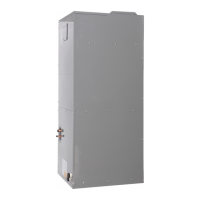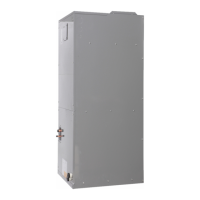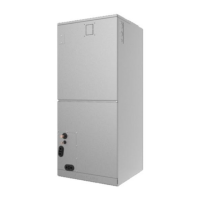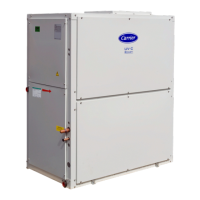40MBAB: Installation Instructions
Manufacturer reserves the right to change, at any time, specifications and designs without notice and without obligations.
14
13. Thread this lineset through the wall to connect to the indoor unit.
14. Refer to the liquid line and gas line connection O.D. sizes in Table 6 based
on the model being installed. Cut and deburr the tubing (review
“Remove
Burrs” on page 13
) to prepare it for brazing. Setup the nitrogen apparatus
and connect to the outside unit to flow nitrogen while brazing. Braze the
tubing and any fittings to obtain a proper seal.
15. Adjust the nitrogen apparatus to pressurize the system. Pressure test
the system to a maximum of 500 psig for at least 60 minutes.
16. Insulate suction line completely, including the outdoor unit valves.
17. Brazing Adapter (Optional)
When flare to braze adapter is used, follow these steps:
a. Refer to the liquid line and gas line connection O.D. sizes in
Table 6 on page 12 based on the model being installed. Cut and
deburr the tubing (review “Remove Burrs” on page 13) to
prepare it for brazing. Setup the nitrogen apparatus and
connect to the outside unit to flow nitrogen while brazing.
Braze the tubing and any fittings to obtain a proper seal.
b. Adjust the nitrogen apparatus to pressurize the system.
Pressure test the system to a maximum of 500 psig for at least
60 minutes.
c. Insulate suction line completely, including the outdoor unit
valves.
Step 7 - Evacuate Coil and Tubing System
Refrigerant tubes and the indoor coil should be evacuated using the
recommended 500 microns deep vacuum method. The alternate triple
evacuation method may be used if the procedure outlined below is
followed.
NOTE: Always break a vacuum with dry nitrogen.
Using Vacuum Pump
1. Completely tighten flare nuts A, B, C, D, connect the manifold gage
charge hose to a charge port of the low side service valve (see Fig.
39).
2. Connect the charge hose to vacuum pump.
3. Fully open the low side of manifold gage (see Fig. 40).
4. Start the vacuum pump.
5. Evacuate using either the deep vacuum or triple evacuation method.
6. After evacuation is complete, fully close the low side of manifold
gage and stop the vacuum pump operation.
7. The factory charge contained in the outdoor unit is good for up to 25
ft. (8 m) of line length. For refrigerant lines longer than 25 ft. (8 m),
add refrigerant, up to the allowable length.
8. Disconnect the charge hose from the charge connection of the low
side service valve.
9. Fully open service valves B and A.
10. Securely tighten the service valve caps.
A220816
Fig. 39 —Service Valve
A220790
Fig. 40 — Manifold
Evacuation
Evacuation of the system removes air or nitrogen (non-condensables) as well
as moisture. A proper vacuum will assure a tight, dry system before charging
with refrigerant. The two methods used to evacuate a system are the deep
vacuum method and the triple vacuum method.
Deep Vacuum Method
The deep vacuum method requires a vacuum pump capable of pulling a
vacuum of 500 microns and a vacuum gauge capable of accurately
measuring this vacuum depth. The deep vacuum method is the most
positive way of assuring a system is free of air and moisture.
NOTE: DO NOT add a filter line drier.
A220817
Fig. 41 —Deep Vacuum Graph
Wrap insulation around the piping. Direct contact with the bare
piping may result in burns or frostbite. Ensure the pipe is properly
connected. Over tightening may damage the bell mouth and under
tightening may lead to leakage.
CAUTION
UNIT DAMAGE HAZARD
Failure to follow this caution may result in equipment damage or
improper operation. Never use the system compressor as a vacuum
pump.
CAUTION
Outdoor Unit Indoor UnitRefrigerant
Service Valve
Low Side
High Side
A
B
C
D
500
01234 567
1000
1500
LEAK IN
SYSTEM
VACUUM TIGHT
TOO WET
TIGHT
DRY SYSTEM
2000
MICRONS
2500
3000
3500
4000
4500
5000

